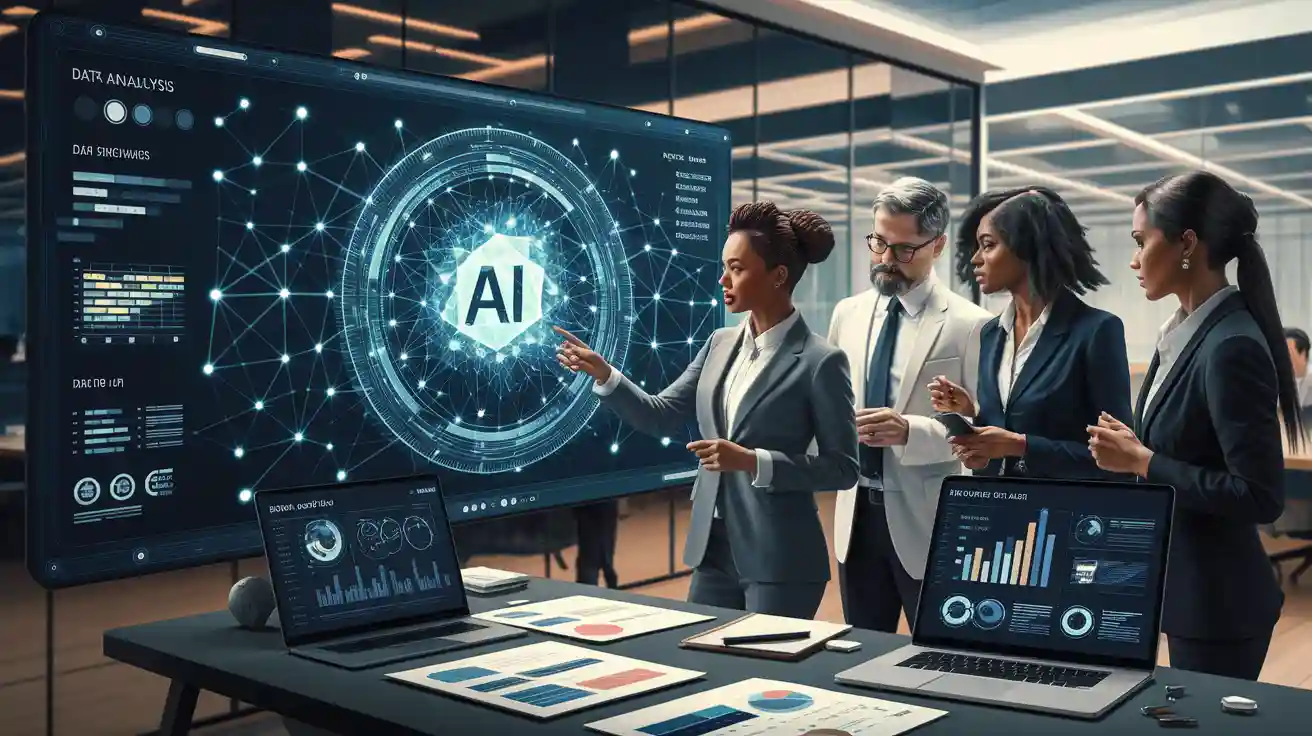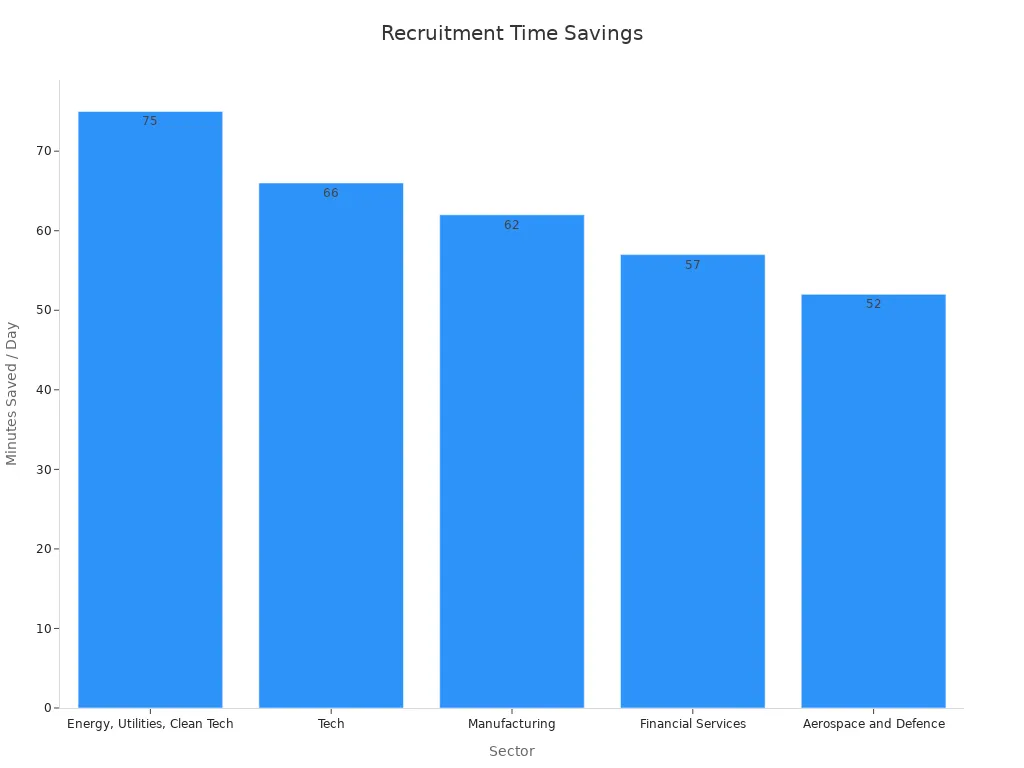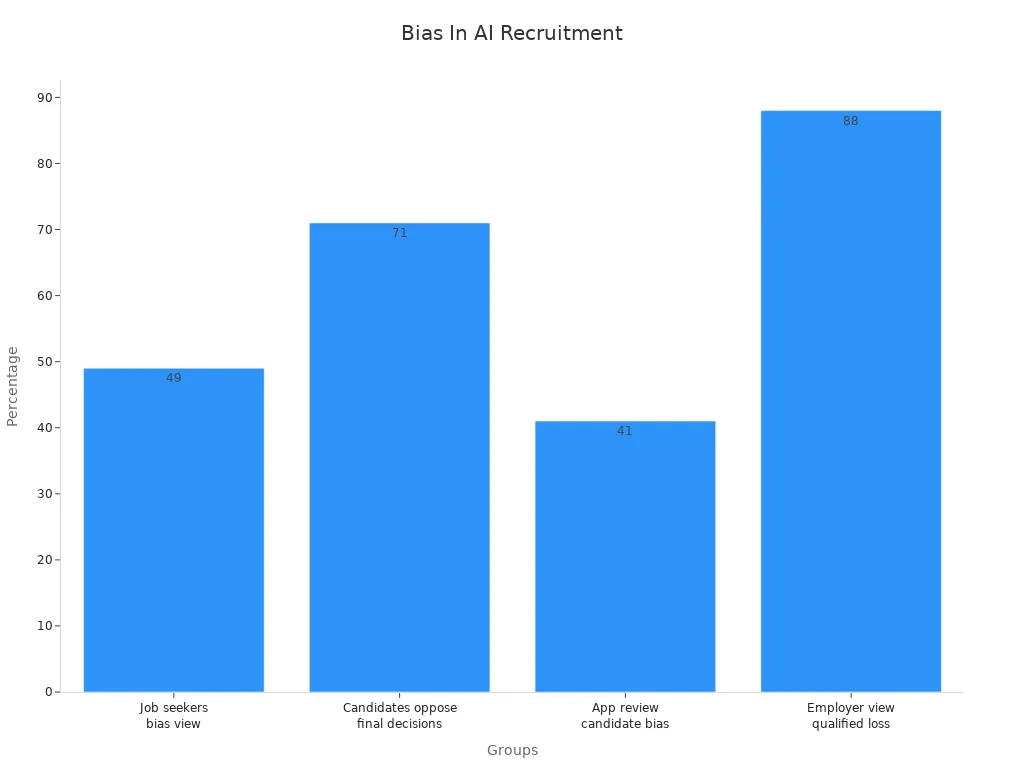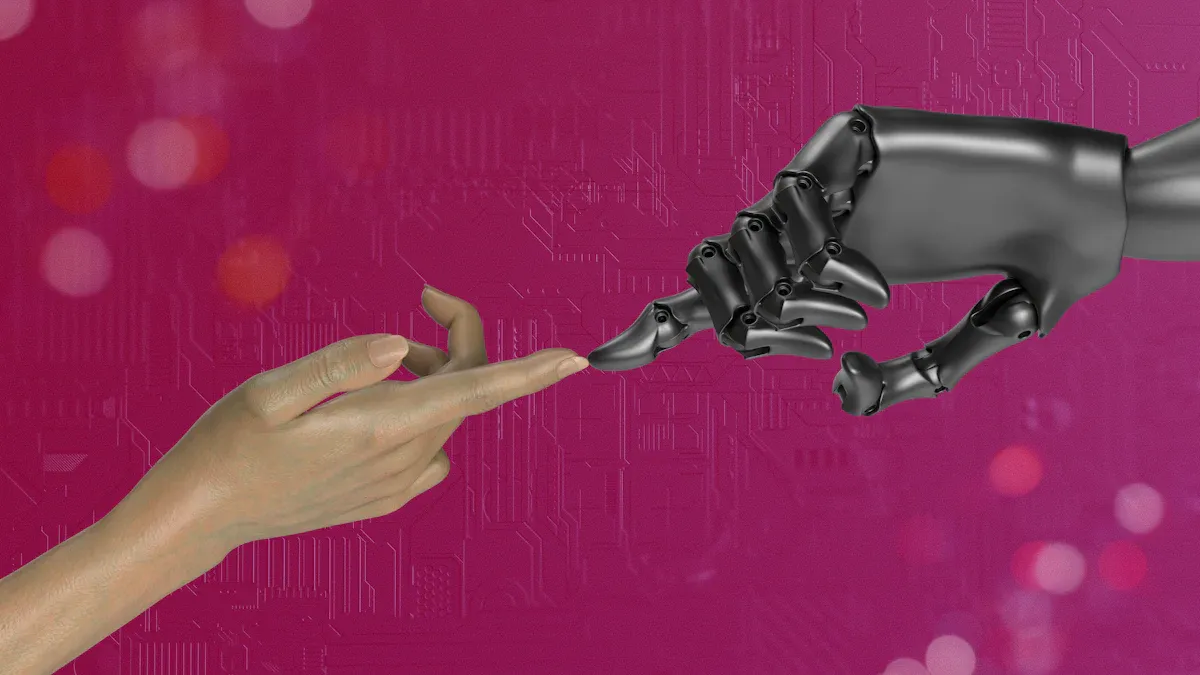
Recruitment inefficiencies can slow you down and cost your company top talent. Artificial intelligence is changing this landscape by streamlining hiring processes. For example, 86% of recruiters say AI tools improve efficiency, reducing time-to-hire by up to 70%. AI recruiting also boosts candidate quality by 24%, helping you find the right fit faster.
Key Takeaways
-
AI tools help cut hiring time a lot. Some companies now hire in 7 days instead of 60. This helps recruiters fill jobs quickly and work on other tasks.
-
AI makes hiring better by removing unfit applicants. This creates a stronger group of candidates and better hires.
-
Checking AI systems often is important to keep things fair. It builds trust with job seekers and supports fair hiring practices.
Key Benefits of AI in Recruitment

Enhanced Efficiency and Time Savings
AI simplifies the recruitment process by automating repetitive tasks like scheduling interviews and screening resumes. This allows you to focus on building relationships with top candidates. For example, AI recruitment tools can analyze vast amounts of candidate data in minutes, significantly reducing the time-to-hire. A recent study found that companies using AI report a 67% reduction in screening time, enabling faster hiring decisions.
AI also saves time across industries. In the tech sector, recruiters save an average of 66 minutes per day, while those in manufacturing save 62 minutes. These time savings translate into more efficient workflows and better use of your team's resources.

Improved Candidate Matching and Quality of Hires
AI-powered recruitment platforms enhance candidate matching by analyzing skills, experience, and cultural fit. This ensures you connect with candidates who align with your organization's needs. AI filters out 60% of unqualified applicants, leaving you with a higher-quality talent pool.
Metrics also highlight the impact of AI in recruitment. Time-to-hire has dropped from 60 days to just 7 days in some cases. Recruiters have saved 800 hours annually, freeing up two-thirds of their time for strategic tasks. Additionally, candidate satisfaction scores have reached an impressive 93%, reflecting a better overall candidate experience.
|
Metric |
Value |
|---|---|
|
Time-to-hire |
Dropped from 60 days to just 7 |
|
Hours saved for recruiters |
800 hours saved annually |
|
Candidate satisfaction score |
93% CSAT score |
|
Annual hours saved |
1,695 hours through automation |
Cost Savings Through Automation
AI recruitment tools reduce costs by automating administrative tasks and eliminating the need for multiple platforms. For instance, a large retail client using AI reduced its cost-per-hire by 71%, saving over $3 million annually. This demonstrates how automation can optimize your recruitment budget.
Additionally, 93% of companies using AI report cost savings. By automating up to 70% of manual work, AI allows HR teams to allocate resources more efficiently. This not only lowers expenses but also improves the overall recruitment process.
Data-Driven Decision Making for Better Outcomes
AI tools provide valuable data insights that help you make informed hiring decisions. These tools assess candidates for skills, cultural fit, and personality traits, ensuring better matches. Data-driven metrics like time-to-fill and cost-per-hire allow you to refine your recruitment strategies over time.
AI also enhances talent acquisition by identifying patterns and trends in candidate behavior. This enables you to predict hiring outcomes and adjust your approach accordingly. By leveraging AI, you can create smarter recruitment strategies that deliver long-term success.
Popular AI-Powered Tools and Their Applications
AI Chatbots for Candidate Engagement
AI chatbots revolutionize how you interact with candidates during the recruitment process. These tools streamline communication, ensuring quick responses and personalized attention. For example, Humanly and Paradox's AI assistant Olivia automate initial interactions and scheduling, providing 24/7 support. This ensures candidates feel valued and engaged throughout their journey.
AI chatbots also improve candidate experience metrics. Studies show that 41% of organizations already use AI chatbots for engagement, and these tools significantly enhance efficiency and satisfaction. By automating repetitive tasks, chatbots allow you to focus on building meaningful connections with top talent.
Resume Screening and Parsing Tools
AI recruitment tools excel at resume screenings, saving you time and improving accuracy. Machine learning algorithms analyze resumes to identify patterns linked to successful hires. These tools reduce initial screening time by 80% and improve the quality of shortlisted candidates by 60%.
Advanced parsing systems also adapt as they process more data, ensuring evaluations remain relevant. By automating resume reviews, you can eliminate human biases and focus on the most qualified candidates.
Predictive Analytics for Talent Acquisition
Predictive analytics transforms talent acquisition by using data to forecast hiring outcomes. AI recruitment platforms analyze past decisions to identify trends and predict candidate success. This allows you to make smarter, data-driven hiring decisions.
These tools also optimize resource allocation. By identifying high-potential candidates early, you can reduce time-to-hire and improve overall recruitment efficiency.
AI-Powered Video Interview Platforms
AI-powered video interview platforms simplify the hiring process by automating initial screenings. These tools provide consistent evaluations, ensuring fair comparisons across candidates. Data-driven insights also minimize human error, promoting objective assessments.
Platforms like these save time and resources. For instance, they reduce screening time by up to 80% and improve application completion rates from 50% to 85%. By focusing on measurable criteria, these tools enhance candidate experience and ensure better hiring outcomes.
Ethical Considerations in AI Recruitment
Addressing Bias in AI Algorithms
AI algorithms can unintentionally perpetuate bias, impacting hiring decisions. Nearly half of employed U.S. job seekers believe AI recruitment tools are more biased than human counterparts. This perception stems from the way AI systems learn from historical data, which may include biased patterns. For example, if past hiring decisions favored certain demographics, AI could replicate these biases.
|
Statistic |
Description |
|---|---|
|
Nearly half of employed US job seekers believe AI recruitment tools are more biased than human counterparts. |
|
|
71% |
A significant majority of U.S. candidates oppose AI in final hiring decisions. |
|
41% |
A notable percentage of candidates oppose AI's use in reviewing job applications. |
|
88% |
A large majority of employers agree that applicant tracking systems are vetting out qualified high-skill candidates. |

To mitigate bias, you should conduct regular audits of AI systems. These audits identify problematic patterns and ensure fairness in recruitment processes. Additionally, developing technologies that actively reduce bias can help create more equitable hiring practices. AI should complement human judgment, not replace it, especially in final hiring decisions.
Ensuring Candidate Privacy and Data Security
AI recruitment tools collect extensive candidate data, raising concerns about privacy and security. Sensitive information, such as employment history and personal identifiers, can be exposed to unauthorized access. In 2023, the average cost of a data breach in HR-related AI systems reached $4.45 million, highlighting the financial risks of inadequate security measures.
-
AI systems can expose candidates to identity theft and phishing attacks.
-
Many platforms lack clear consent policies, leaving candidates unaware of how their data is handled.
-
Unauthorized data access can lead to misuse, compromising candidate trust.
To address these challenges, you should implement robust data protection protocols. Encryption and secure storage systems can safeguard candidate information. Transparency in data usage policies is equally important. Informing candidates about how their data is collected and used builds trust and ensures compliance with regulations like GDPR.
Promoting Transparency in AI-Driven Decisions
Transparency is essential for building trust in AI-driven recruitment processes. Candidates need to understand how AI influences hiring decisions. Clear explanations of AI's role foster accountability and encourage engagement. For example, organizations should inform candidates about data usage and obtain explicit consent.
|
Evidence Point |
Description |
|---|---|
|
Importance of Transparency |
Transparency is crucial for building trust with candidates and ensuring fair practices in AI-driven recruitment. |
|
Data Privacy Principles |
Organizations must inform candidates about data usage and obtain explicit consent, emphasizing transparency in the recruitment process. |
|
Ethical Communication |
Clear explanations of AI's role in hiring decisions foster trust and accountability, encouraging candidate engagement. |
AI systems should also provide insights into decision-making processes. This ensures fairness and allows candidates to understand why certain decisions were made. By prioritizing transparency, you can create a recruitment environment that values ethical practices and builds stronger relationships with candidates.
Real-World Examples of AI in Recruitment

Case Study: AI-Driven Resume Screening at Unilever
Unilever revolutionized its recruitment process by adopting AI-driven resume screening tools. These tools assessed over a million applications in just days, reducing hiring time by 75%. The company eliminated traditional resumes, instead focusing on AI-powered assessments to evaluate candidates. This approach led to a 50% increase in diversity among new hires and a 90% reduction in time-to-hire.
Unilever successfully hired 30,000 employees in one year using this method. The AI recruitment tools also removed unconscious bias, ensuring a fairer selection process. By leveraging automation, Unilever created a more efficient and inclusive recruitment process that set a new standard for hiring practices.
Case Study: Chatbots Enhancing Candidate Experience at L’Oréal
L’Oréal implemented the AI chatbot ‘Mya' to streamline its recruitment process. Mya automated initial screenings, conducted first-round interviews, and answered candidate queries. This innovation reduced the average time spent per applicant by 40 minutes and saved approximately $250,000 in recruiter wages.
The chatbot also improved the candidate experience by providing timely feedback and reducing application drop-off rates. L’Oréal reported a 33% reduction in time-to-hire and a more diverse group of interns. By integrating AI recruitment tools like Mya, the company enhanced efficiency and ensured a positive experience for candidates.
Case Study: Predictive Analytics Improving Hiring Outcomes at IBM
IBM uses predictive analytics to improve hiring accuracy and retention. The company’s AI recruitment platforms analyze resumes and match candidates with job requirements. This approach increased hiring accuracy by 30% and significantly reduced turnover rates.
IBM’s Talent Acquisition Metrics Dashboard tracks key metrics like source of hire and quality of hire. Employees hired through predictive analytics are 55% more likely to stay after four years. These tools enable IBM to make data-driven decisions, ensuring long-term success in talent acquisition.
Best Practices for Integrating AI into Recruitment Workflows
Start Small and Scale Gradually
When integrating AI into your recruitment process, starting small is key. Begin with a pilot project or proof of concept (PoC) to test AI recruitment tools in a controlled environment. This approach allows you to gather feedback and refine strategies before scaling. For example, structured experiments can help you measure the effectiveness of AI applications and identify areas for improvement.
Tip: Monitor key performance indicators (KPIs) during pilot projects to assess the impact of AI on candidate sourcing and selection. This data provides valuable insights for broader implementation.
Gradual scaling ensures smoother transitions and minimizes disruptions. By testing AI-powered recruitment tools incrementally, you can adapt to challenges and optimize workflows effectively.
Train Recruiters to Work Alongside AI
Training your recruiters to collaborate with AI systems enhances hiring outcomes. Hands-on sessions can demonstrate practical uses of AI, such as narrowing down candidates and identifying patterns. This training empowers recruiters to combine AI insights with their expertise, improving decision-making.
-
Training helps recruiters interact with AI tools effectively.
-
It fosters a deeper understanding of AI’s role in recruitment strategies.
-
Recruiters gain confidence in leveraging AI for tasks like initial screenings and talent acquisition.
By equipping your team with the skills to work alongside AI, you create a balanced approach that maximizes the benefits of automation while retaining human judgment.
Regularly Audit AI Tools for Fairness and Accuracy
Regular audits of AI recruitment systems ensure fairness and accuracy in hiring decisions. These audits evaluate datasets, algorithms, and decision-making processes to identify and address biases.
|
Metric Type |
Description |
|---|---|
|
Ensures datasets encompass all relevant demographics, reducing underrepresentation. |
|
|
Bias Detection Frameworks |
Tools like IBM AI Fairness 360 and Google’s What-If Tool provide metrics to evaluate bias. |
|
Explainability Techniques |
Methods like SHAP and LIME illuminate decision-making pathways, enabling bias identification. |
|
Algorithmic Audits |
Regular audits by independent parties assess and address potential biases throughout the AI lifecycle. |
Note: Incorporating human oversight in decision-making reduces risks of automated bias and ensures ethical recruitment practices.
Auditing AI recruitment tools regularly helps you maintain transparency and build trust with candidates, ensuring a fair recruitment process.
Maintain a Balance Between AI and Human Judgment
AI recruiting systems excel at processing large volumes of data quickly, but human judgment remains essential for complex hiring decisions. Recruiters bring emotional intelligence and nuanced understanding to the table, which AI cannot replicate.
-
AI can identify patterns and trends, but human recruiters assess cultural fit and long-term potential.
-
Over-reliance on AI may lead to deskilling of recruiters, diminishing their ability to evaluate intangible qualities.
-
Ethical considerations, such as a candidate’s history of behavior, require human oversight to ensure accountability.
A collaborative approach ensures AI enhances, rather than replaces, human expertise. By maintaining this balance, you can achieve smarter recruitment strategies that prioritize both efficiency and fairness.
AI transforms hiring processes by automating tasks and improving efficiency. However, responsible implementation is vital. Diverse training data reduces bias, while explainable AI fosters transparency. Minimizing data collection protects candidate privacy. Combining AI with human expertise ensures smarter recruitment strategies that prioritize fairness, trust, and better outcomes for your organization.
FAQ
What is the main advantage of using AI in recruitment?
AI improves efficiency by automating repetitive tasks like resume screening and scheduling. This allows you to focus on strategic hiring decisions and candidate engagement.
How does AI ensure fair hiring practices?
AI reduces bias by analyzing data objectively. Regular audits and diverse training datasets help you maintain fairness and promote equitable recruitment processes.
Can AI completely replace human recruiters?
No, AI complements human recruiters by handling data-driven tasks. You still play a vital role in assessing cultural fit and making final hiring decisions.







